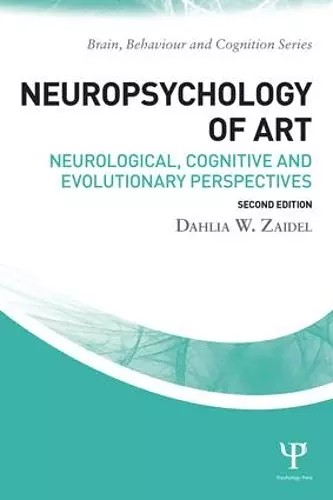Neuropsychology of Art
Neurological, Cognitive, and Evolutionary Perspectives
Format:Paperback
Publisher:Taylor & Francis Ltd
Published:10th Nov '15
Should be back in stock very soon
This paperback is available in another edition too:
- Hardback£155.00(9781138856073)

Fully updated, the second edition of Neuropsychology of Art offers a fascinating exploration of the brain regions and neuronal systems which support artistic creativity, talent and appreciation. This landmark book is the first to draw upon neurological, evolutionary, and cognitive perspectives, and to provide an extensive compilation of neurological case studies of professional painters, composers and musicians.
The book presents evidence from the latest brain research, and develops a multidisciplinary approach, drawing upon theories of brain evolution, biology of art, art trends, archaeology, and anthropology. It considers the consequences of brain damage to the creation of art and the brain’s control of art. The author delves into a variety of neurological conditions in established artists, including unilateral stroke, dementia, Alzheimer’s Disease, Parkinson’s Disease, and also evidence from savants with autism.
Written by a leading neuropsychologist, Neuropsychology of Art will be of great interest to students and researchers in neuropsychology, cognitive psychology, neuroscience, and neurology, and also to clinicians in art therapy.
The new edition of Neuropsychology of Art builds on the many strengths of the first edition by offering a comprehensive treatment of the biological bases of the creation and perception of art. The book should be of great interest to students and researchers seriously interested in empirical approaches to understanding the brain’s role in creativity and art reception. -Oshin Vartanian, Department of Psychology, University of Toronto, Canada
The Neuropsychology of Art is a timeless, must-read text for all those who want to know more about the effects of brain damage on the expression of art – and by implication, the relationship between the expression of art and its representation within the brain. This book is a source of information and inspiration for scientists and clinicians working with brain-damaged individuals. - Nicky Edelstyn, Keele University, UK
The decade since the first edition of Dahlia Zaidel’s extraordinary book has seen major growth in the investigation of the neural basis of art. This second edition revises and updates the new findings. I strongly recommend it to all neuroscientists, scholars, clinicians, and lay readers. -Laura Piccardi, Università dell’Aquila, Italy
The updated edition of Zaidel's The Neuropsychology of Art gives the best, single overview of how various disturbances to the brain can inform our understanding of the role played by the brain in the human species' propensity for creating and experiencing art. By examining changes to perception, cognition, and emotion, Zaidel demonstrates that art behavior is the result of many brain systems, not a single art "module". The Neuropsychology of Art was a seminal publication when it was first published, and remains a must-read cornerstone of the rapidly growing neuroaesthetics literature. - Martin Skov, Center for Decision Neuroscience, Copenhagen Business School, & Danish Research Centre for Magnetic Resonance, Denmark
The new edition of Neuropsychology of Art builds on the many strengths of the first edition by offering a comprehensive treatment of the biological bases of the creation and perception of art. The book should be of great interest to students and researchers seriously interested in empirical approaches to understanding the brain’s role in creativity and art reception. - Oshin Vartanian, Department of Psychology, University of Toronto Scarborough, Canada
Neuropsychology of Art is a timeless, must-read text for all those who want to know more about the effects of brain damage on the expression of art – and by implication, the relationship between the expression of art and its representation within the brain. This book is a source of information and inspiration for scientists and clinicians working with brain-damaged individuals. - Nicky Edelstyn, Keele University, UK
The decade since the first edition of Dahlia Zaidel’s extraordinary book has seen major growth in the investigation of the neural basis of art. This second edition revises and updates the new findings. I strongly recommend it to all neuroscientists, scholars, clinicians, and lay readers. - Laura Piccardi, Università dell’Aquila, Italy
The updated edition of Zaidel's The Neuropsychology of Art gives the best, single overview of how various disturbances to the brain can inform our understanding of the role played by the brain in the human species' propensity for creating and experiencing art. By examining changes to perception, cognition, and emotion, Zaidel demonstrates that art behavior is the result of many brain systems, not a single art "module". The Neuropsychology of Art was a seminal publication when it was first published, and remains a must-read cornerstone of the rapidly growing neuroaesthetics literature. - Martin Skov, Center for Decision Neuroscience, Copenhagen Business School, & Danish Research Centre for Magnetic Resonance, Denmark
The book is comprehensive in scope... Much of the necessary information on anatomy and physiology is given prior to explaining brain damage and deficits... This makes the book ideal as an introductory text for undergraduates... The case study approach will be of great interest to clinical neuropsychologists... Neuropsychology of Art is well worth the read. It provides a broad overview of the research behind how we perceive and produce art, and it does so from a multidisciplinary perspective. It is an idea introducty text on these topics, laying out much of the needed background information. At the same time, it can serve as a reference work for clinical neuropsychologists and researchers in the field of neuroaesthetics. - Jay Friedenberg, Manhattan College, PsycCritiques
ISBN: 9781138856080
Dimensions: unknown
Weight: 394g
272 pages
2nd edition